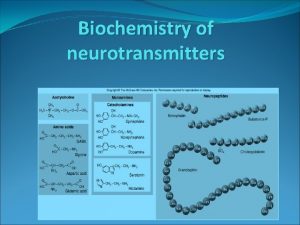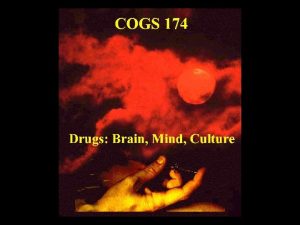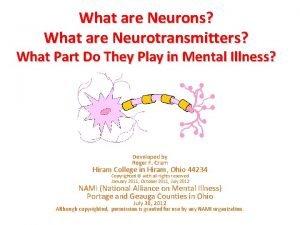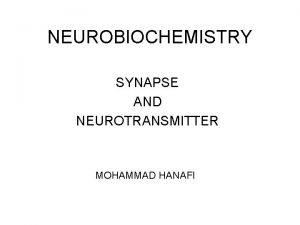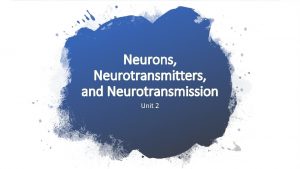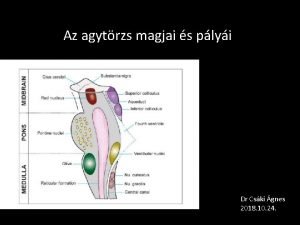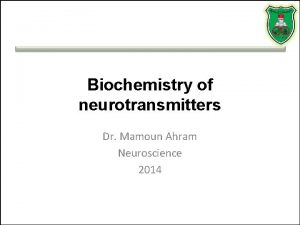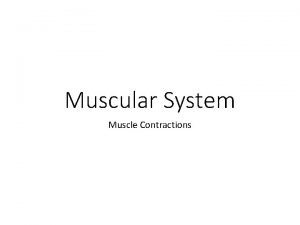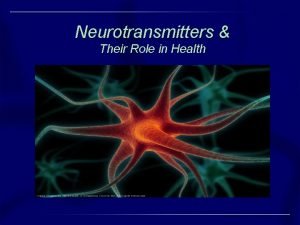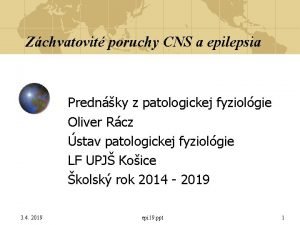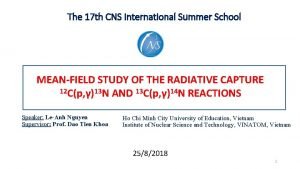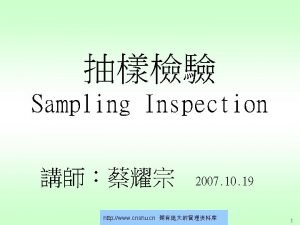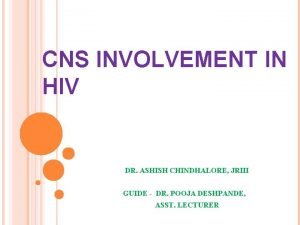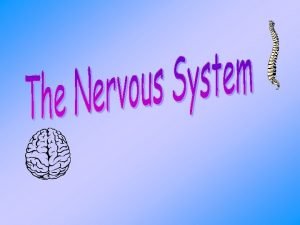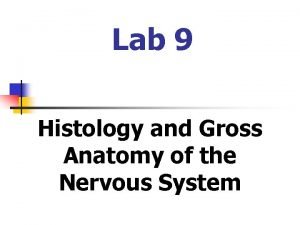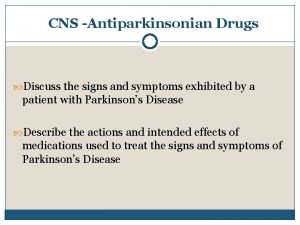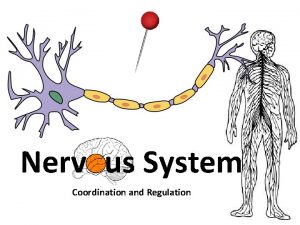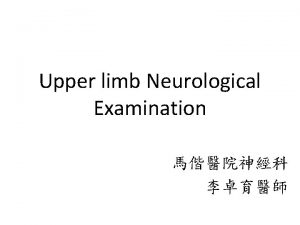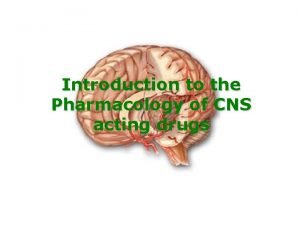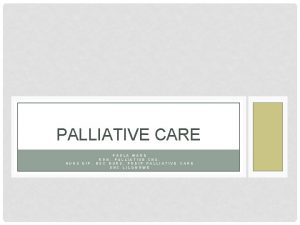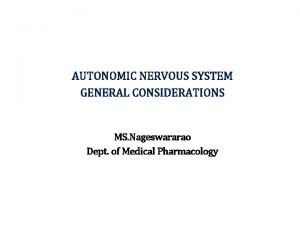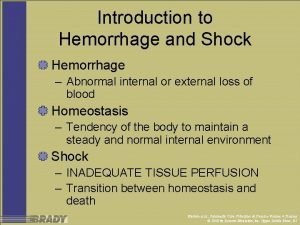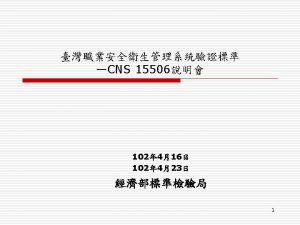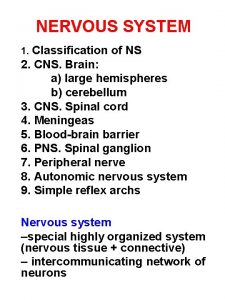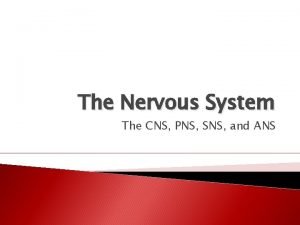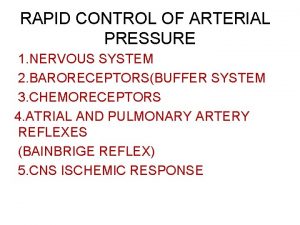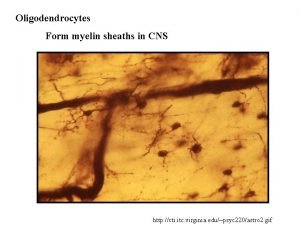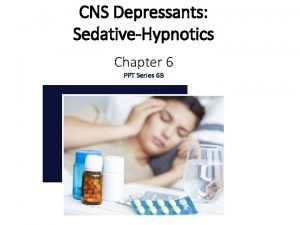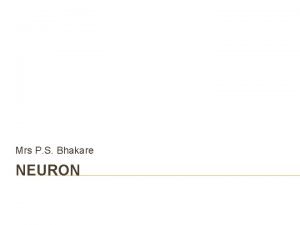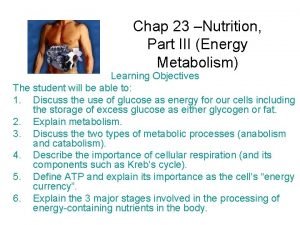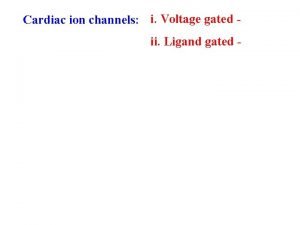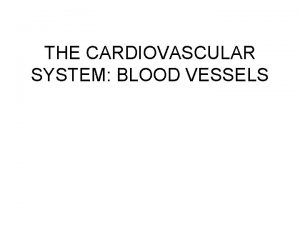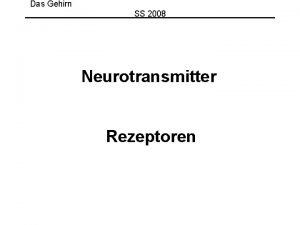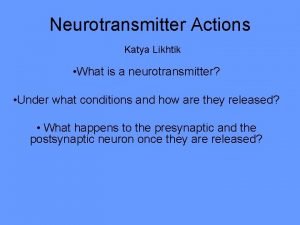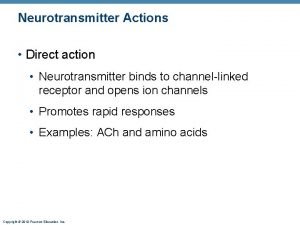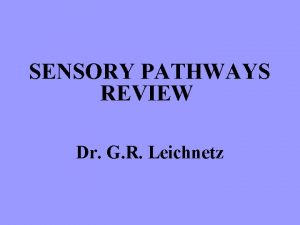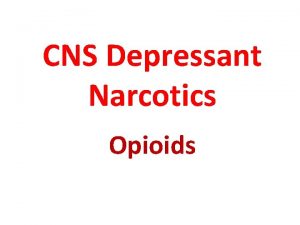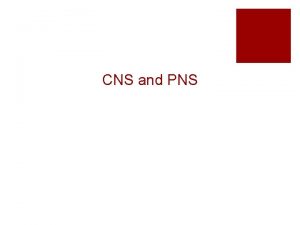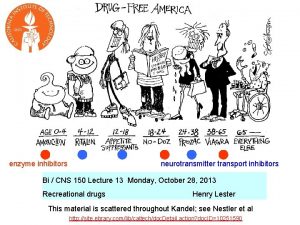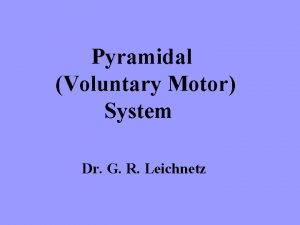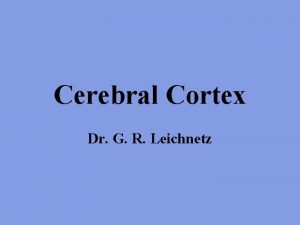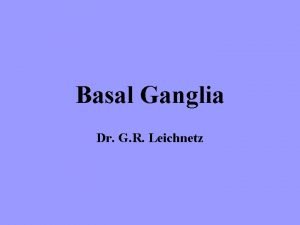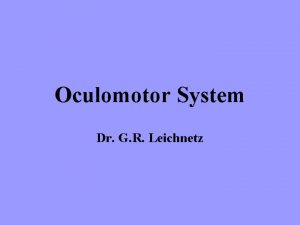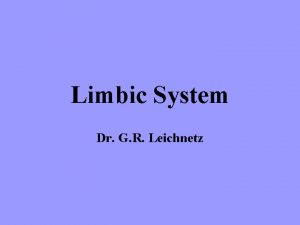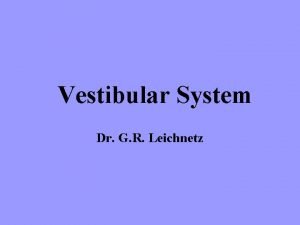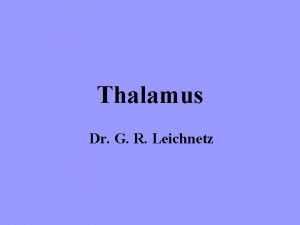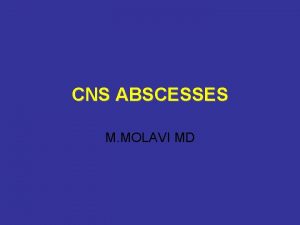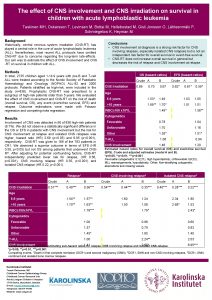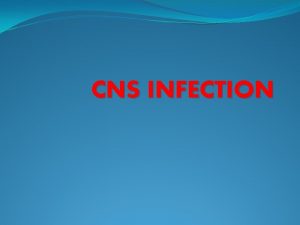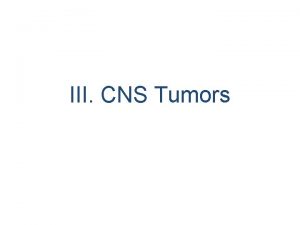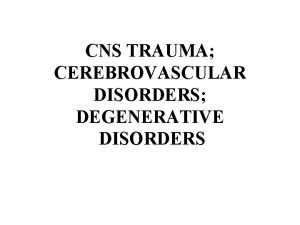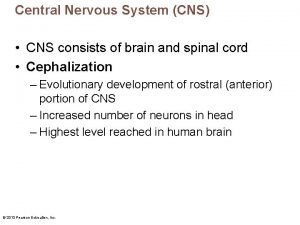CNS Neurotransmitter Pathways Dr G R Leichnetz CNS






















































- Slides: 54

CNS Neurotransmitter Pathways Dr. G. R. Leichnetz

CNS Neurotransmitters Classical (Simple) Neurotransmitters Ionotropic- excitatory, inhibitoryact through ion channels Metabotropic- neuromodulatoryact through G proteins, second messengers Neuropeptides

Simple neurotransmitters are synthesized in the axon terminal, whereas neuropeptides are synthesized in the cell body. They are co-released. Recovery takes longer for neuropeptides to be replaced in the terminal. Raw materials reach the terminal via anterograde axonal transport along microtubules, and byproducts of synthesis travel back to the cell body via retrograde transport.

Principal CNS Neurotransmitters Glutamate- excitatory- approx. 40% GABA - inhibitory- approx 40 % (hard-wired, information-processing systems) Acetylcholine Norepinephrine Dopamine Serotonin (affect background activity of the brain, EEG)

GLUTAMATERGIC SYSTEMS

Pyramidal cells of the cerebral cortex are glutamatergic. They give rise to associational, commissural, and projectional (corticofugal) fibers. III All cortical efferents (corticofugals): corticospinals, corticobulbars corticostriates corticopontines corticothalamics are glutamatergic (excitatory). V Corticofugal Projections Associational Commissural Corticostriate Corticopontine Cortico -spinal Corticobulbar Corticothalamic

Associational fibers (intrahemispheric)- cortico-cortical fibers interconnect cortical regions within the same hemisphere; originate from layer III pyramidal cells and are glutamatergic.

Commissural fibers (interhemispheric)- cortico-cortical fibers interconnect cortical regions in opposite hemispheres; originate from layer III pyramidal cells and are glutamatergic.

Corticofugal projections (cortical efferents) that descend through the internal capsule originate from lamina V pyramidal cells and are glutamatergic.

Thalamocortical projections are also glutamatergic, so that the thalamic inputs to cortex (the principal source of direct afferents) are excitatory. All thalamic nuclei are glutamatergic, except the thalamic reticular nucleus

CM/Pf Intralaminar complex, thalamus Corticostriate projections and thalamostriate projections (to caudate and putamen) are glutamatergic.

Glutamatergic Systems Associational and Commissural Fibers (origin: layer III pyramidal cells) Corticofugal Fiber Systems: (origin: layer V pyramidal cells) corticospinals, corticobulbars, corticopontines, corticostriates, etc. (origin: layer V pyramidal cells) Thalamocorticals Thalamostriates

GABA-ERGIC SYSTEMS

Glutamate is metabolized to GABA by glutamic acid decarboxylase. Antibodies to GAD can be used to label GABA-ergic systems. Glutamate GABA

The substantia nigra has two parts: pars compacta (dopaminergic) and pars reticulata (GABA-ergic) pars reticulata GABA pars compacta (DA)

Nigral Efferents from the SNr are GABAergic Nigrothalamics (to the motor thalamus, VA/VL, and intralaminar nuclei, CM/Pf) Nigrotectals (to SC) SNr

All striatal efferents are GABA-ergic. Striatopallidals to globus pallidus (GPe & GPi) Striatonigrals to substantia nigra (SNc & SNr)

Pallidothalamic projections in the fasciculus lenticularis and ansa lenticularis are GABA-ergic. VA CM/Pf Pallidothalamics follow two different routes to the motor thalamus (VA) Thalamic fasciculus All pallidal efferents are GABA-ergic Pallidal Efferents STN Fasciculus lenticularis Ansa lenticularis

Purkinje cells in the cerebellar cortex are GABA-ergic. Purkinje cell They project their axons to the deep cerebellar nuclei to exert a powerful inhibitory influence on the excitatory output of the cerebellum that originates from the deep nuclei. . Send their axons to deep cerebellar nuclei Deep cerebellar nuclei Emboliform Fastigial Globose Dentate Deep cerebellar nuclei

Granule (stellate) neurons of the cerebral cortex are predominantly GABA-ergic. These cells have short axons which do not leave their local area of cortex and are involved in intrinsic columnar circuitry.

GABA-ergic Systems Nigrotectals, nigrothalamics- from pars reticulata, substantia nigra Striatopallidals, striatonigrals- from striatum (caudate & putamen) Pallidothalamics- from globus pallidus Purkinje cells, cerebellar cortex Granule (stellate) cells, cerebral cortex

CHOLINERGIC SYSTEMS

All cranial nerve motor nuclei (GSE, SVE, GVE) (red) are cholinergic. The oculomotor, trochlear, abducens, and hypoglossal nuclei (GSE), trigeminal & facial nuclei, and nucleus ambiguus (SVE), Edinger-Westphal, sup. & inf. salivatory nuclei, and dorsal motor nucleus of the vagus (GVE) are cholinergic.

Caudate Putamen Cholinergic (ACh) aspiny neurons in the striatum The striatum (caudate and putamen) contains a population of small cholinergic (aspiny) neurons which are involved in intrinsic striatal circuitry (ie. do not give rise to striatal efferents).

Huntington’s Chorea hereditary disease produces atrophy of the striatum (caudate & putamen) with loss of both cholinergic and GABA-ergic neurons. In Huntington’s disease, post-mortem studies show atrophy of the striatum with enlargement of lateral ventricles.

The septum/basal forebrain region contains numerous cholinergic cell groups (Ch 1 -Ch 4), the largest of which is the nucleus basalis of Meynert (Ch 4). SEPTUM Septum BASAL FOREBRAIN NBM Ch 4 Ch 1 -Ch 3

The nucleus basalis of Meynert (Ch 4) is the principal source of the cholinergic innervation of the cerebral cortex. Ch 4

In Alzheimer’s disease, the nucleus basalis (Ch 4) shows about a 75% loss of neurons, leading to a profound depletion of acetylcholine in the cortex which is thought to be at least partially responsible for the cognitive and memory loss in the disease. In Alzheimer’s disease, postmortem studies show atrophy of associational areas of the cortex, neuritic plaques, and neurofibrillary tangles within cortical neurons.

Post-mortem studies show a profound loss of cholinergic neurons in the nucleus basalis of Meynert Ch 4). Normal Alzheimer’s In the normal brain, the nucleus basalis of Meynert contains abundant large Nissl-rich cholinergic neurons that actively synthesize acetylcholine.

The pedunculopontine nucleus (Ch 5) is the principal source of the cholinergic innervation of subcortical structures. It provides the cholinergic trigger for onset of REM sleep. Ch 5

Cholinergic Systems Brainstem motor nuclei- GSE, SVE, GVE Striatum- intrinsic conn. ’s, aspiny neurons Basal Forebrain- Ch 1 -Ch 4 - proj. ’s to cortex Nucleus basalis of Meynert (Ch 4) Dorsolateral pontine tegmentum- proj’s to subcortical structures Ch 5 - pedunculopontine nucleus

NORADRENERGIC SYSTEMS

The catecholamine metabolic pathway for the synthesis of dopamine and norepinephrine begins with the amino acid tyrosine. Dopamine Norepinephrine

The locus ceruleus (A 6), located in the periaqueductal gray of the rostral pons, is the principal source of norepinephrine in the brain. The locus ceruleus (A 6) contains large numbers of neurons whose cytoplasm is filled with neuromelanin, a byproduct of catecholamine (NE) synthesis.

LC Locus ceruleus (A 6) neurons has long ascending and descending branches which supply NE to all levels of the neuraxis. These projections become activated in arousal, anxiety (CNS aspects of “fight or flight”). The ascending fibers constitute the dorsal NE bundle, which traverse the MFB to reach higher levels of the CNS.

The other NE-producing cell groups (eg. A 5, A 7) in the lateral pontine and medullary reticular formation give rise to ascending projections to the hypothalamus (Ventral NE bundle) and (A 1 -A 3) descending projections to the spinal cord. HYPOTHALAMUS A 5 A 7 A 1 -A 3 NE projections from A 5, A 7 to hypothalamus, and nuclei in brainstem and spinal cord (A 1 A 3) associated with control of visceromotor activities.

Noradrenergic Systems Dorsal Noradrenergic Bundle- from locus ceruleus (A 6) to entire CNS, except hypothalamus Ventral Noradrenergic Bundle- from A 5, A 7 in lateral pontine and medullary reticular formation to hypothalamus A 1 -A 3 gives rise to NE descending projections to the spinal cord (visceromotor, autonomic nuclei)

DOPAMINERGIC SYSTEMS

Substantia Nigra The pars compacta of the substantia nigra contains dopaminergic neurons whose cytoplasm is filled with abundant neuromelanin, a byproduct of catecholamine (DA) synthesis.

Most CNS dopaminergic neurons are located in the ventral midbrain in the substantia nigra pars compacta (A 8, A 9) and ventral tegmental area (A 10). Red nucleus A 10 A 8, A 9

The nigrostriatal projection from the pars compacta of the SN to the caudate and putamen is dopaminergic. Loss of dopaminergic neurons in the SNpc is associated with Parkinson’s disease. L-dopa therapy is recommended to replace depleted DA (crosses blood brain barrier) Post-mortem section of the midbrain from a patient with Parkinson’s disease shows loss of neuromelanin in the SN

The ventral tegmental area (A 10) contains the cells of origin of the dopaminergic mesolimbic & mesocortical tracts (“reward system”). A 10

The mesolimbic and mesocortical tracts, which originate from the VTA (A 10) traverse the medial forebrain bundle in the lateral hypothalamus to reach the nucleus accumbens and prefrontal cortex. PFC NA VTA SNc Mesocortical to prefrontal cortex Mesolimbic “Reward System” to Nuc. Accumbens

The nucleus accumbens of the basal forebrain is the principal target of the mesolimbic tract (“reward system”) and has been called the “center for addiction. ” It contains receptors for a large number of chemical substances of abuse. NA

Dopamine Hypothesis (“teeter-totter”) Dopamine effects on movement. Elevated acetylcholine Depleted dopamine Depleted acetylcholine Elevated dopamine

Dopamine Hypothesis Dopamine effects on mood Elevated Dopamine Depleted dopamine

Dopaminergic Systems Nigrostriatals- from pars compacta (A 8, A 9), substantia nigra to caudate & putamen (Parkinson’s disease) Mesolimbic (“Reward System”)- from ventral tegmental area (A 10) to basal forebrain (nuc. accumbens) Mesocortical- from ventral tegmental area (A 10) to prefrontal cortex

SEROTONERGIC SYSTEMS

The biosynthetic pathway for the synthesis of the indoleamine serotonin begins with the amino acid tryptophan. Serotonin

The serotonin-producing cell groups are located in the median reticular formation (raphe) of the brainstem. The midbrain raphe contains the dorsal raphe nucleus (B 7) and superior central nucleus (B 8). The medullary raphe contains the nucleus raphe pallidus, obscurus, and magnus (B 1 -B 3).

Dorsal raphe nucleus B 7 IV MLF B 8 This cross section of the monkey brain at the level of the caudal midbrain/ rostral pons, stained using antibodies to serotonin, shows that serotonin-producing cell groups are clustered around the raphe. Superior central nucleus

Ascending serotonergic (5 -HT) projections project to all structures at higher levels of the CNS and are involved in synchronized sleep. Descending 5 -HT projections to the spinal cord are involved in analgesia (B 3) and effects on motor tone (B 1, B 2).

B 3 The nucleus raphe magnus (B 3) of the medullary raphe, whose neurons are activated by morphine, projects via the raphespinal tract to the layers of the spinal cord dorsal horn (laminae I and V) that receive nociceptive (painful) stimuli). Illustrates the role of descending serotonergic projections in analgesia.

Serotonergic Systems Ascending Projections- from midbrain raphe (B 7, dorsal raphe nucleus; B 8, superior central nucleus) to higher CNS levels Descending Projections- from medullary raphe to spinal cord B 3 Nucleus Raphe Magnus to dorsal horn, modulation of pain B 1, B 2 Nucleus Raphe Obscurus, Pallidus to intermediate and ventral horns, influence autonomics and movement
 Neurotransmitters in somatic nervous system
Neurotransmitters in somatic nervous system Cross bridge myosin head
Cross bridge myosin head What is acetylcholine responsible for
What is acetylcholine responsible for Life cycle of a neurotransmitter
Life cycle of a neurotransmitter Kandel
Kandel Neurotransmitter
Neurotransmitter Summary of neurotransmitters
Summary of neurotransmitters Metabolisme
Metabolisme What neurotransmitter is scarce during depression
What neurotransmitter is scarce during depression Neurotransmitter
Neurotransmitter Whats a neurotransmitter
Whats a neurotransmitter Tr tectospinalis
Tr tectospinalis Small-molecule neurotransmitters
Small-molecule neurotransmitters This neurotransmitter is __________.
This neurotransmitter is __________. Taurine neurotransmitter
Taurine neurotransmitter Cns poruchy
Cns poruchy Neutron capture
Neutron capture Atrail
Atrail Iso 2859抽樣計畫表
Iso 2859抽樣計畫表 Soma cns
Soma cns Cns depressants classification
Cns depressants classification What is central nervous system
What is central nervous system Tuberculomas
Tuberculomas Composition of cns
Composition of cns Neuron type
Neuron type Sensory system diagram
Sensory system diagram Www.lispa.it cns
Www.lispa.it cns Naas community national school
Naas community national school Pagitane
Pagitane Depresori cns
Depresori cns Cns
Cns Depresori cns
Depresori cns Stretch reflexes
Stretch reflexes Cns ischemic response
Cns ischemic response Cns
Cns Cns ward
Cns ward Ans and cns difference
Ans and cns difference Haemorrhage
Haemorrhage Cns 15506
Cns 15506 Meningeas
Meningeas Cns international school
Cns international school Cns and sns
Cns and sns Cns ischemic response
Cns ischemic response Cns educar
Cns educar Cnscp
Cnscp Cns
Cns Cns depressants ppt
Cns depressants ppt Nervous system histology ppt
Nervous system histology ppt Soma cns
Soma cns Chapter 7 a closer look energy metabolism pathways
Chapter 7 a closer look energy metabolism pathways Internodal pathways
Internodal pathways Base excision repair vs mismatch repair
Base excision repair vs mismatch repair New pathways for youth jobs
New pathways for youth jobs Aboriginal pathways campbelltown
Aboriginal pathways campbelltown Blood
Blood


